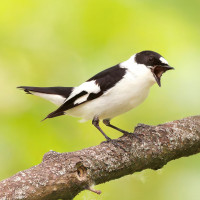Beschreibung
The Weißstorch breeding colony in Marchegg is located behind the castle. Just follow the signs leading to a path across a small bridge. Further nest sites are located on the roof of the castle and in the park around the castle so you can find different spots for great observations. The Weißstorch usually arrive at the end of March and occupy the old nests, which are then mended and prepared for the new season. In early April you can watch the storks displaying and mating and in May you can spot chicks in the nests. Later in summer one can observe the young ones learning to fly before they leave south in late August.
Apart from the watch tower next to the stork colony, there is a bird hide at a small lake, where Eisvogel is often seen. Grauschnäpper, Graureiher and sometimes also Purpurreiher can be found here as well, and if you are lucky you might spot a Flußseeschwalbe on its migration. Throughout the forest you can find (or rather hear) amongst others, Waldbaumläufer, Halsbandschnäpper, Mönchsgrasmücke, Zilpzalp and several species of woodpecker.
This area is also home to rare amphibians (e.g. Moor frog (Rana arvalis), European fire-bellied toad (Bombina bombina)) and the European beaver (Castor fiber). Moreover, Konik horses are bred here and can be seen in their paddock next to the lake or foraging through the forest.
Continuing on the dam to the east of the castle, the tour takes you to the March river where you can find different species of swallows and might spot Schwarzmilan or Rotmilan. Here the path turns to the south viewing a floodable meadow. Girlitz, Goldammer, Grünfink, Neuntöter can be spotted here, among others.
Depending on the season, you can look for migrating waders at the small lake at the end of the circuit – or take a swim at its east side. You can take the same way back to the castle or stroll through the village back to the car park.
Details
Zugang
Best accessible by car. There is a car park next to Marchegg Castle.
Terrain und Habitat
Wald , Vereinzelte Bäume und Büsche , See , Fluss , Stadt/DorfBedingungen
FlachRundweg
JaIst ein Spektiv nützlich?
Möglicherweise hilfreichGute Beobachtungszeit
Frühjahr , SommerBeste Beobachtungszeit
Frühjahr , SommerRoute
Normaler WegSchwierigkeitsgrad der Tour
EinfachErreichbarkeit
zu FußBeobachtungshütten oder -türme
JaZusätzliche Informationen
There is a WWF infopoint where you can obtain folders pointing out itineraries through the WWF nature reserve and the riparian forest. It is also possible to join guided tours through the area between May and October. However, since the paths are well marked, you will easily find your way through the area even when the infopoint is closed.





